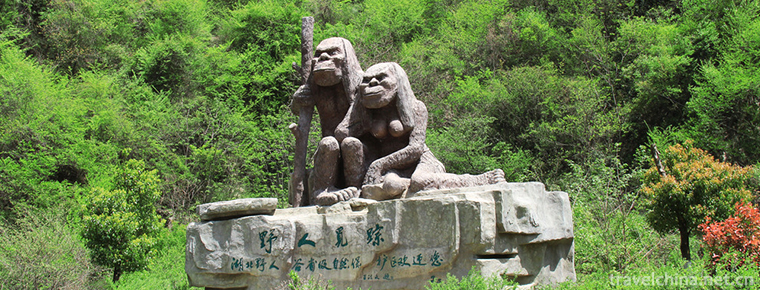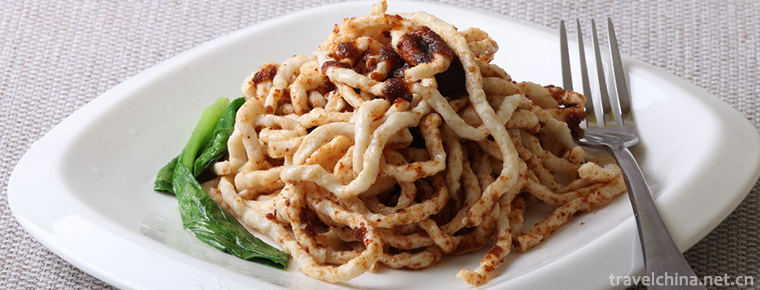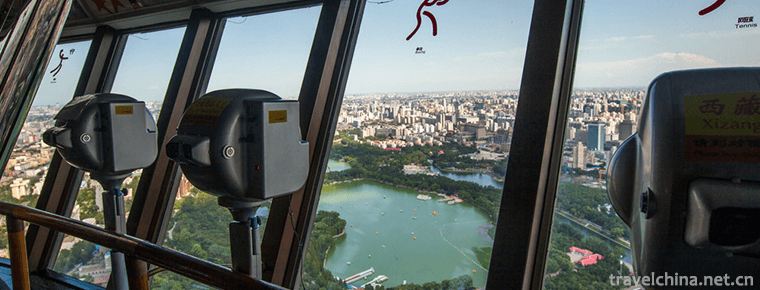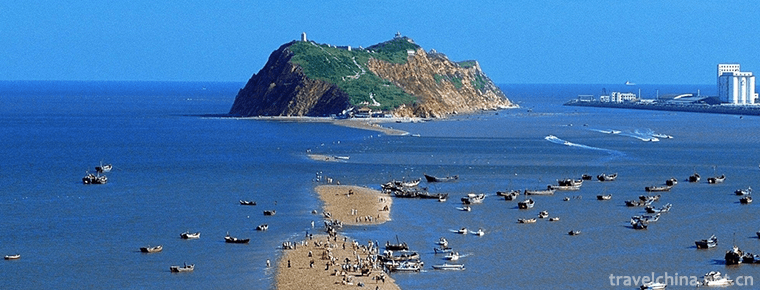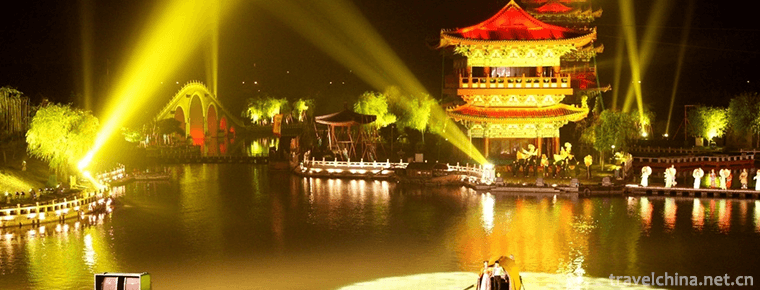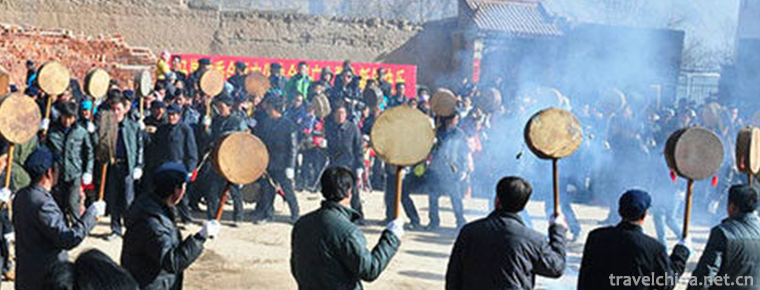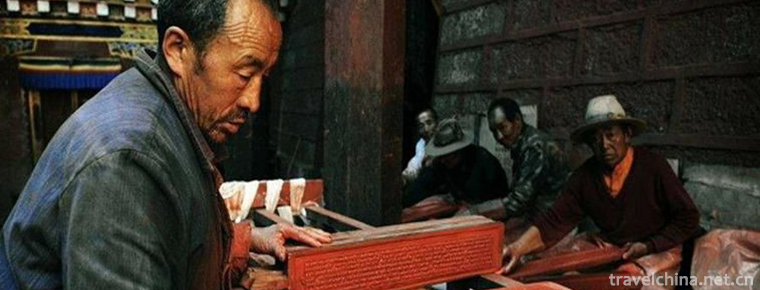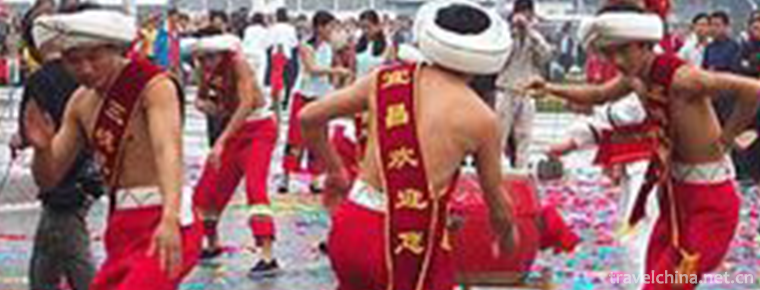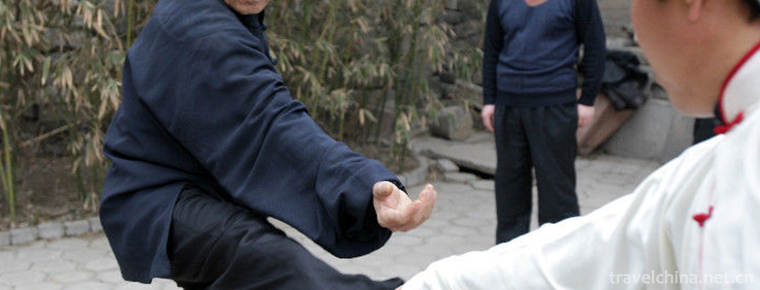Yangjiabu woodcut New Year paintings
Yangjiabu woodcut New Year paintings
Yangjiabu wood engraving New Year's picture is a traditional folk engraving which is spread in Weifang City, Shandong Province. Its production method is simple, exquisite craft, bright color, rich content. Every year, the theme of Spring Festival New Year pictures will be changed. Many new ideas and new things will be reflected in the New Year pictures immediately after they appear, which will play a certain role in promoting social progress. In addition, Yangjiabu woodcut New Year pictures also indirectly record the situation of Chinese folk houses and civil society life, which has a certain reference value for the study of ancient Chinese culture. Yangjiabu woodcut New Year's pictures have strong local flavor and unique production technology. They are also known as the three major origins of Chinese woodcut prints with Yangliuqing in Tianjin and Taohuawu in Suzhou.
On May 20, 2006, Yangjiabu woodcut New Year pictures were approved by the State Council and listed in the first batch of national intangible cultural heritage list.
History of Development
During the Hongwu period of the Ming Dynasty, the woodcut New Year pictures of Yangjiabu had a preliminary technological basis.
After the second year of Longqing in the Ming Dynasty (1568 A.D.), the ancestors of Yangjiabu established Hengshun, Tongshuntang, Wanzengcheng, Tianhe and Yonghe painting shops successively.
The "Jixing" New Year Painting Workshop, built in Chongzhen, Ming Dynasty, covers an area of 239.4 square meters and has 11 houses, which are well preserved.
From Ming Dynasty to early Qing Dynasty, there were Tongshuntang, Jixing, Taihe, Gongmao, Hengshun and so on, which depended on the development of New Year painting industry. At the end of the Ming Dynasty, it was destroyed by war.
In the early Qing Dynasty, New Year pictures were restored and developed. Wanshun, Gongxing, Gongyi, Gongtai, Yongsheng and other more than 30 painting shops are engaged in the production of New Year's paintings in large quantities.
During the reign of Qianlong in Qing Dynasty, woodcut New Year pictures were highly developed and prosperous. In the next century and a half, Yangjiabu New Year Paintings, with its variety, large scale and wide sales range, stood side by side with Yangliuqing New Year Paintings in Tianjin and Taohuawu New Year Paintings in Suzhou, and became one of the three famous Chinese folk painting markets for a time. At this time, there were many painting shops, 82 of which were opened by Yang's family in Xiyang Port alone.
During the Xianfeng period of the Qing Dynasty, Yangjiabu New Year's Paintings reached a glorious period, with hundreds of painters and thousands of kinds of paintings. Most of the products of New Year's Paintings were sold in China.
At the end of the Qing Dynasty and the beginning of the Republic of China, the woodcut New Year pictures began to innovate in the form of altered images. Yang Jiujing of Dashun Painting Store, representing the requirements of innovators, founded Dongdashun Painting Store.
Manufacturing Technology
Yangjiabu New Year's Picture has its own unique craftsmanship. The artist first paints with willow charcoal sticks and fragrance, called "rotten manuscripts". On the basis of rotten manuscripts, the artist completes the original manuscript, draws the line manuscript, and sticks it back on the pear wood plate for sculpture, and carves the line plate and the color plate separately. After color mixing, paper clipping, plate mixing, color processing, manual printing. After the New Year's pictures are printed, they should be simply depicted with various colors added by hand to make the New Year's pictures appear natural and vivid.
The production of Yangjiabu New Year's Pictures is divided into painting, sculpture, printing, mounting and other processes, each process is extremely fine and accurate. The method is to draw the black line draft first, stick it on the planned pear or tangerine board, and carve out the main line version. After the main line draft is printed, different colours are carved, and the printing is done in set colours. Finally, the repaired version is mounted and mounted.
Artistic Characteristics
Yangjiabu woodcut New Year pictures have gradually developed and perfected in accordance with farmers'ideological requirements, customs and beliefs, aesthetic views and living needs, forming its own simple, simple and bright style. It is rooted in the folk and decorated in festivals. It has long played a role in enriching people's spiritual life, reflecting people's good wishes and beautifying people's Festival environment.
The artistic features of Yangjiabu woodcut New Year's pictures are as follows: free from the constraints of nature, expressing themes with rich imagination, generalization, romanticism, symbolism and implication; complete, full and symmetrical composition; exaggerated, concise, rough and simple shape. When making New Year's pictures, artists first use willow charcoal sticks and incense to paint, called "rotten manuscripts", on this basis, then complete the original manuscript, draw line manuscripts, carve out line plate and color plate respectively, and print by hand. After the New Year pictures are printed, they are manually filled with various colors and simply depicted to make them more natural and vivid.
Subject works
Yangjiabu woodcut New Year pictures can be divided into door gods, Kangtou paintings, curtain paintings, Zhongtang paintings, practical New Year pictures, strip screen paintings and so on. According to the theme classification, there are praying for good luck Yingxiang New Year pictures, guarding against evil spirits, auspicious New Year pictures, custom New Year pictures, production of labor-themed New Year pictures, novel plays and myths and legends New Year pictures, landscapes and flowers, rare birds and animals New Year pictures, current affairs humor, hundred operas entertainment New Year pictures and so on.
It has a wide range of subjects and forms. Mainly: pray for good luck, eliminate disasters and eliminate disasters; beautiful dolls, auspicious joy; human relations, men farming and women weaving; fiction, drama, myths and legends; landscapes, flowers, birds and animals; current news, satirical humor; and some for practical purposes, serving people's real life.
Ming Dynasty New Year paintings are meticulous and elegant. At first, the theme of Yangjiabu Folk Woodcut New Year's pictures was relatively narrow, mainly engraved God portrait New Year's pictures. To meet the requirements of folk superstition, we mainly draw Kitchen King, Door God, Bodhisattva, Jade Emperor and so on. In the aspect of painting, some of them are based on religious wood depiction, such as Three Generations of Families, Shenta Yu Lei Door God, and others are based on fiction, drama and illustrations of science and technology books, such as Minzishan, Men Huang, etc. Ten busy","February 2"and so on.
In the early Qing Dynasty, the variety of New Year's paintings increased and the technique of carving became more sophisticated, resulting in a large number of excellent works, such as Zhang Xian Shooting Dogs, Annual Fish, Liu Hai Opera Golden Bug and Bogu Four Screens, which were stable and rhythmic. The theme of New Year's pictures has expanded unprecedentedly, and the paintings of gods praying for good fortune and welcoming good fortune and eliminating disasters have become more complete. The forms of New Year's pictures can be divided into gate painting, door painting and Kangtou painting.
At the end of the Qing Dynasty, the artists of New Year's paintings no longer followed the example and began to innovate. First of all, the new New Year's pictures began to focus on drama stories and case stories, such as "Cherry Striking", "Empty City Plan", "Fishing and Killing Home" and so on. Secondly, the auspicious paintings of "getting rich and making money" such as "Five Ways to Get Rich, Getting Rich and Returning Home", "Money Tree", "Spring Bull", "Three Masters" and so on. These works provide spiritual sustenance and comfort to the people who suffered from the invasion of great powers and the rise of thieves. The representative works are Deer Crane in the Spring, Pomegranate in the Hundred Seeds, Five Blessings for Life, etc.
At the end of the Qing Dynasty and the beginning of the Republic of China, innovative painters broke through the stereotypes of Yangjiabu New Year's paintings and absorbed the characteristics of other paintings. New paintings, such as "Four Seasons Flowers and Birds" and "Eight Immortals Tiaoping", were full of frustration and vividness. They also absorb the interest of Chinese painting brush and ink, with a single ink color, divided into several levels of printing, printing into "ink goods", such as "four screens of mountains and rivers", simple and elegant, can be sold throughout the year.
After the founding of New China, folk artists created a large number of New Year's paintings, such as Water Margin, Emperor's Map, Journey to the West and so on. They have wonderful composition, fine carving, vivid, and rich local flavor.
Inheritance and Protection
After the founding of New China, the woodcut New Year pictures of Yangjiabu, once depressed due to the war, were revitalized.
In 1951 and 1952, the Ministry of Culture of East China Bureau and the Shandong Provincial Bureau of Culture sent two people to conduct a comprehensive survey of Yangjiabu New Year pictures, and created 22 New Year pictures successively, which provided new experience for the inheritance and development of Yangjiabu New Year pictures. After that, many professional artists devoted themselves to the creation of Yangjiabu New Year pictures. On the basis of traditional craftsmanship, it absorbs historical and modern production methods, sublimates Yangjiabu New Year Pictures, excavates, collates and innovates them, and creates a large number of new paintings.
In 1952, 7.8 million woodcut New Year pictures were printed in Yangjiabu.
In 1979, the former Weixian government established the Yangjiabu Wood Engraving New Year Painting Research Institute, which specializes in excavating, sorting out and innovating Yangjiabu Wood Engraving New Year Painting.
After the Third Plenary Session of the Eleventh Central Committee, new momentum of development has emerged in Yangjiabu woodcut New Year pictures. Annual production of more than 10 million New Year pictures, exported to more than 80 countries and regions in the world. During the Spring Festival of 1980, Yangliuqing in Tianjin, Yangjiabu in Hantang and Taohuawu in Suzhou held three joint exhibitions of New Year's paintings in Shihuayuan Garden, Weifang City, which provided opportunities for artists and spectators to observe and learn.
During the Spring Festival of 1983, 36 woodcut New Year pictures of Yangjiabu were displayed in the Chinese Art Museum. In the same year, Yang Jiabu's New Year Pictures toured nine countries in America, Europe and Africa.
In 1986, five traditional New Year Painting Workshops and one New Year Painting Exhibition Hall were built in Yangjiabu Village with government funding.
In 1987, folk artist Yang Fuyuan was invited to Singapore to perform woodcut New Year's paintings, engraving and printing. In the winter of the same year, the Ministry of Culture ordered 1500 copies of Yang Jiabu's woodcut New Year pictures, such as "Eight Immortals" and "New Year Picture Lens", and distributed them to embassies of more than 20 countries in Beijing, thus promoting international cultural exchanges.
From 1988 to 1989, a group of artists of Yangjiabu New Year Painting were sent to Brazil and Japan for demonstration performances of painting, engraving and printing, which were well received.
In 2002, Yang Luoshu, the authentic heir of Tongshunde Painting Store and folk artist of New Year's Painting, was awarded the honorary title of "Master of Folk Arts and Crafts" by UNESCO.
On May 20, 2006, Yangjiabu woodcut New Year pictures were approved by the State Council and listed in the first batch of national intangible cultural heritage list.
On June 5, 2007, determined by the Ministry of Culture, Yang Luoshu of Weifang City, Shandong Province, was the representative successor of this cultural heritage project, and was included in the list of 226 representative successors of the first batch of national intangible cultural heritage projects.
The woodcut New Year pictures produced by Yang Jiabu reached more than 20 million pieces, and were exported to more than 100 countries and regions all over the country and the world. Yangjiabu has become an important station on the Qianli Folklore Tourism Line in Weifang, Shandong Province. There, people can enjoy more than 100 sets of excellent New Year's paintings, witness a variety of tools and original versions of New Year's paintings since the Ming Dynasty, and watch the production process of mysterious New Year's paintings on the spot.
However, Yangjiabu woodcut New Year pictures also have some worries. First, the theme of New Year's pictures is lack of novelty, and second, there are few successors who can systematically and truly grasp the skills and essence of woodcut New Year's pictures, except for several living old artists, which will directly affect the development and survival of Yangjiabu woodcut New Year's pictures. Therefore, the rescue project of folk culture should be started as soon as possible to create a favorable environment for the protection and development of Yangjiabu woodcut New Year pictures.

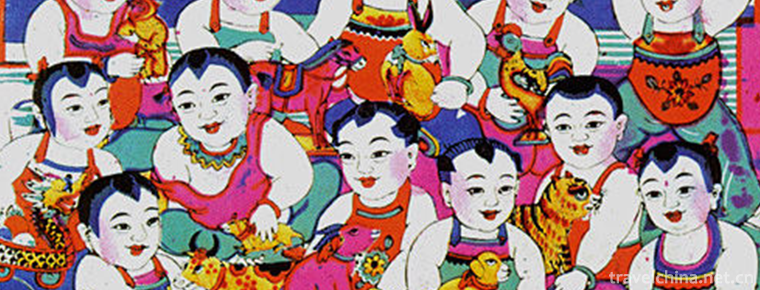
-
Shennongjia Forestry DistrictHubei Shennongjia
Shennongjia Forest District, referred to as Shennongjia for short, was established in 1970 with the approval of the State Council and directly under the jurisdiction of Hubei Province. .
Views: 234 Time 2018-10-28 -
sate noodles
The only disciple chef Wang Daquan who teaches Shacha Noodle recipe by the master of Southern Fujian cuisine Yang Jibo inherits the tradition and makes it flourish. The main ingredients of Shacha sauc.
Views: 170 Time 2018-11-02 -
Mingsha Mountain Crescent Spring Scenic Area
Mingsha Mountain Crescent Spring Scenic Spot is located 5 kilometers south of Dunhuang City, Gansu Province. It covers an area of 312,000 square kilometers.
Views: 80 Time 2018-12-12 -
Central Radio and Television Tower
The Central Radio and Television Tower, now a national 4A scenic spot, is located on the west side of West Third Ring Road, Haidian District, Beijing. Near the Space Bridge, it faces beautiful Yuyuant.
Views: 141 Time 2018-12-22 -
Bijiashan Scenic Area
Bijiashan Scenic Area is located in Tianqiao Town, Jinzhou City, Liaoning Province. The main scenic spots are Bijiashan Island and "Tianqiao", which are divided into five areas: island sight.
Views: 131 Time 2019-01-02 -
Shanghe Garden Scenic Spot in Qingming Dynasty
Qingming Shanghe Garden is a large-scale theme park of Song Dynasty cultural scenery constructed by the people's government of Kaifeng City in Henan Province.
Views: 176 Time 2019-02-07 -
Badang dance
Badang Dance is a kind of ancient folk dance, which originated from the ancient Qiang people's "Temple Festival" in Dingxi Minxian, southeastern Gansu Province. It is also a sacrificial ritu.
Views: 189 Time 2019-04-02 -
Tibetan Engraving and Printing Skills of Dege School of Printing
Tibetan engraving and printing skills of Dege Printing Institute, local traditional handicraft skills of Dege County, Sichuan Province, and one of the national intangible cultural heritages..
Views: 199 Time 2019-04-26 -
Pipa Art
In the history of modern Chinese traditional folk music, there are two schools of pipa: the "Shanghai School" (Pudong School) and the "Zhejiang School" (Pinghu School). The Pipa ar.
Views: 103 Time 2019-06-09 -
Sayerhao of Tujia Nationality
"Sayeer Hao" of Tujia nationality in Changyang, Hubei Province is a kind of sacrificial song and dance of Tujia nationality in the middle reaches of Qingjiang River valley. "Sayer Haw&q.
Views: 367 Time 2019-06-23 -
Elbow pounding
This is a rather mysterious school, which originated from a famous family in Linqing, and is closely related to the chivalrous spirit inherent in the Chinese people; it is a fierce school, but it has .
Views: 417 Time 2019-08-10 -
Meishan peoples life
In 2019, the per capita disposable income of urban residents is 36743 yuan, an increase of 9.0%. The per capita consumption expenditure of urban residents was 23554 yuan, an increase of 12.0%; the per capita disposable income of rural residents was 18177.
Views: 341 Time 2020-12-18
